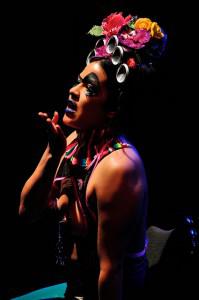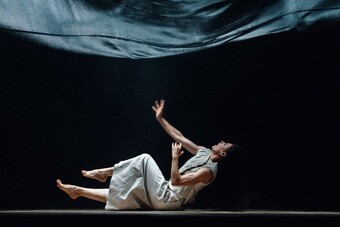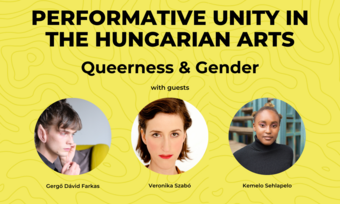Making Way for Queer Experiments
An Interview with Kolmel WithLove
Whether it’s a black box theater or the form-fillable fields of a grant application, queer performance doesn’t always fit neatly into a box. When performing artist and curator Kolmel WithLove, a veteran artist in SOMArts Cultural Center’s time-based performance marathon 100 Performances for The Hole, approached us with a request to make a special place in our programming for The News, she made a case for a collaboration we couldn’t refuse.
Kolmel saw an unfilled need in the Bay Area performing artist community—she noted a dearth of settings outside of bars or traditional theater spaces where performers could showcase works-in-progress, experiment, take risks and generate dialog. SOMArts saw an opportunity to nurture a community of artists by creating a space for experimentation, cross-pollination and resource leveraging among artists who tend to converge by discipline or geography in the Bay Area. The

Xandra Ibarra
News is also an opportunity to bring enthusiastic audiences something fresh, something that might even make them think about performance differently.
Thus The News, a monthly first Tuesdays showing of new and in-progress queer works, was born. SOMArts would provide a venue, technical and publicity support, and Kolmel would seek out and recruit a dynamic array of working artists each month, perform and host The News. Supporting new and challenging work in this way was a learning experience for both our organization, and for Kolmel, a first time performance series curator.
Kolmel, what inspired you to ask for SOMArts’ support in producing and presenting The News?
When I lived in L.A., I performed and attended Queer Mondays, a monthly performance night at Highways Performance Space hosted and created by Ian MacKinnon. It was a rather freeform evening that welcomed performance of all kinds, gave performers a venue to take risks, and generated dialogue in the queer and arts communities. The evening wasn’t focused on new work, but the new work was the most valuable and exciting part of the evening for both audience and performer.
When I went from being in a long distance relationship to becoming domestic partners with San Francisco as a full time resident last summer, I called all of the local arts organizations, but wasn’t able to find a San Francisco equivalent of Queer Mondays.
I didn’t set out to create a new evening, but I saw a gap in what I thought was an important and essential opportunity for the queer arts community—a viable, professional, available and recurring forum to take risks. That’s when I approached SOMArts.
How do you define “queer” performance?
“Queer” performance is work made by someone who identifies as queer or a work that queers performance (as in perverts, subverts, challenges) or work that an artists deems as relevant to dialogue with queerness, transness, gayness, fagottry, drag, political activism and/or homo pageantry.
Does the word “curator” aptly describe your role with The News?
I book work that I think will be absolutely fantastic and work that I think will be completely awful. I am often very wrong. But my opinion doesn’t matter—by offering a wide selection I’m asking the audience to decide what is “good.” I also perform, which is something drag queens do, but not curators.
I book work that I think will be absolutely fantastic and work that I think will be completely awful. I am often very wrong.
How do you decide when a submitted work is appropriate?
Anyone can apply to perform by filling out an easy form that encourages the artist to be vague and change their mind as needed. I have learned that inviting flexibility generates interesting work. There is so much in the art world that you have to write a lot for and so many application processes require an artist to have the piece more or less laid out in advance to be considered for a residency or grant. If the point is to foster and support artists in taking risks and breaking new ground, there needs to be more trust in the artist and real room for discovery.
When I receive submissions, I ask the work three questions: Is it technically possible? Is it really ten minutes or less? Is it genuinely new? If all three are a yes, I book it.
What are performers doing with their ten minutes?
Artists are taking The News as an opportunity to showcase a snippet from a work in progress, or try something completely new. They seem to really understand the spirit of the evening and aren’t trying to reformat or fit an older piece to fit the time limit. That is the crux of why it works.
Some might say the true home of “experimental performance” isn’t on stage. With the exception of a men’s room performance and a few roving performances in the gallery, why do you think so many artists have chosen to perform on the stage?
Artists are allowed and encouraged to perform anywhere, but the stage offers the kind of professional tech that is hard for performers to find elsewhere, and that is really exciting for them. Also, the amount of work needed to rearrange the space to make it more ‘simple’ or ‘egalitarian’ is in truth neither of those things; it is exceedingly more difficult and labor intensive for SOMArts and the artists to alter the space.
That said, I’m thinking of doing something soon in the round or something raw with no technical support, but I don’t want artists to change their pieces for a theme—that’s the antithesis of what the evening is about.
How do you set the audience’s expectations at the beginning of the show?
I remind the audience that all the work is ten minutes or less, so if they hate a piece, it’s no big deal because it will be over soon, and if they love it, they should go see the artist perform again.
I always assert that we as audience need to question how we qualify “good.” recognize our own laziness and complacency and hopefully really disagree with one another. But, most importantly, I remind them to not be afraid to disagree and to keep talking about it.
Was there one performance that made you say to yourself, “This! This is why I created The News! To give this a space to happen!”?
After every show I think “Wow. That just happened.” The show as a whole is the most important part. I also don’t think my opinion about the individual pieces matters. I am proud of the artists when I see them really take risks like perform out of a bar for the first time, in a new collaboration, in a new medium or do something outside their comfort zone. I’m proud for them and proud that I’ve created a space for that.
Kolmel WithLove is the creator and the host of The News. Kolmel, curates, builds cameras and costumes, collaborates with other artists, makes films, and performs. Kolmel has performed in venues including Yerba Buena Center for The Arts, SOMArts Cultural Center, Highways Performance Space, The Velaslavasay Panorama Theatre, The Garage, various galleries, a few living rooms, two very nice leather bars, and a piano lounge.
La Chica Boom performing at The News, photo by Josué Rivera















Comments
The article is just the start of the conversation—we want to know what you think about this subject, too! HowlRound is a space for knowledge-sharing, and we welcome spirited, thoughtful, and on-topic dialogue. Find our full comments policy here